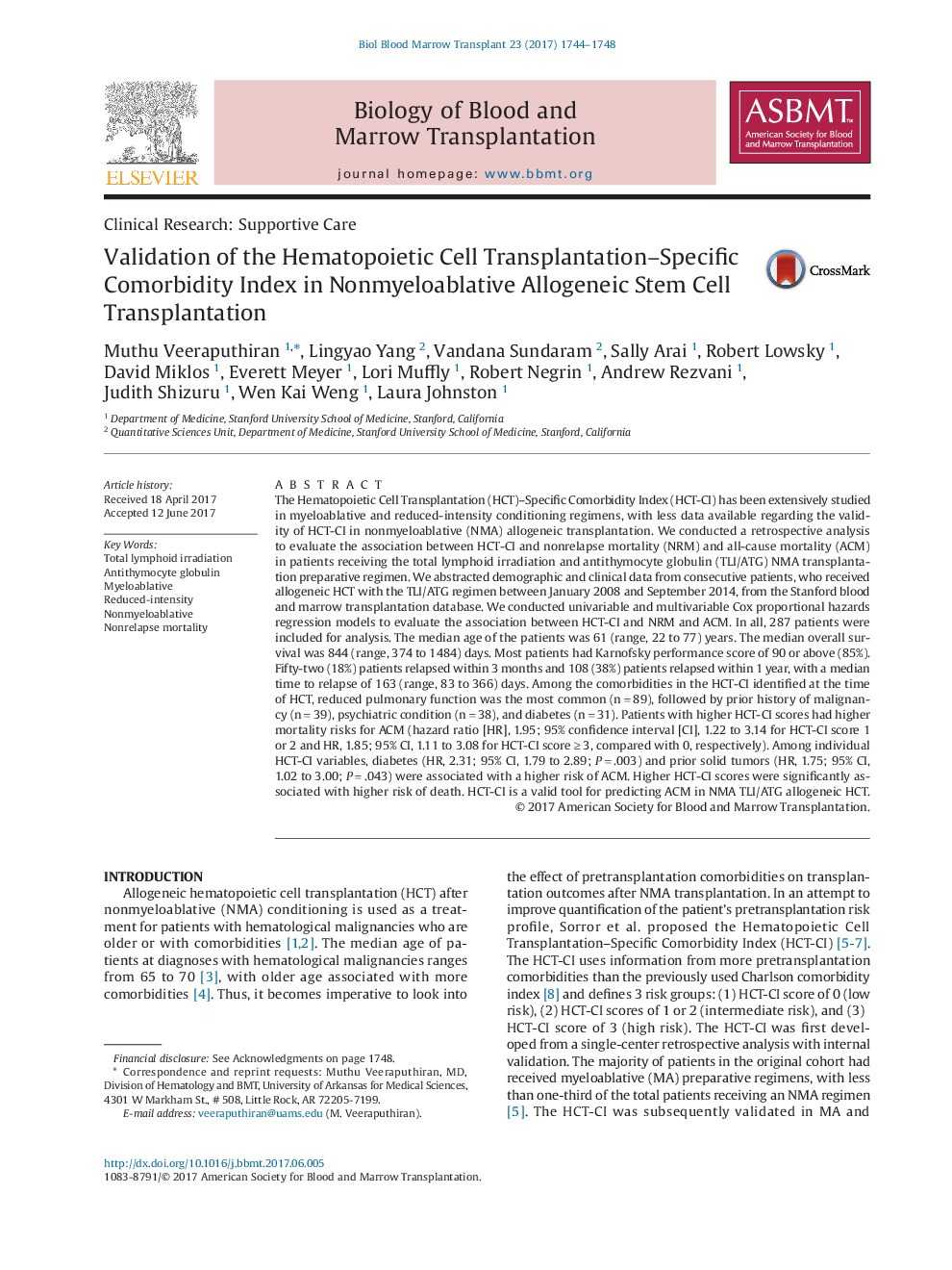| کد مقاله | کد نشریه | سال انتشار | مقاله انگلیسی | نسخه تمام متن |
|---|---|---|---|---|
| 5524061 | 1546236 | 2017 | 5 صفحه PDF | دانلود رایگان |

- This is the first study to evaluate the role of the Hematopoietic Cell Transplantation-Specific Comorbidity Index in patients uniformly receiving nonmyeloablative conditioning
- This is the largest study of a single cohort of patients receiving nonmyeloablative conditioning with total lymphoid irradiation/antithymocyte globulin regimen
- The Hematopoietic Cell Transplantation-Specific Comorbidity Index in nonmyeloablative setting is associated with all-cause mortality but not with nonrelapse mortality
The Hematopoietic Cell Transplantation (HCT)-Specific Comorbidity Index (HCT-CI) has been extensively studied in myeloablative and reduced-intensity conditioning regimens, with less data available regarding the validity of HCT-CI in nonmyeloablative (NMA) allogeneic transplantation. We conducted a retrospective analysis to evaluate the association between HCT-CI and nonrelapse mortality (NRM) and all-cause mortality (ACM) in patients receiving the total lymphoid irradiation and antithymocyte globulin (TLI/ATG) NMA transplantation preparative regimen. We abstracted demographic and clinical data from consecutive patients, who received allogeneic HCT with the TLI/ATG regimen between January 2008 and September 2014, from the Stanford blood and marrow transplantation database. We conducted univariable and multivariable Cox proportional hazards regression models to evaluate the association between HCT-CI and NRM and ACM. In all, 287 patients were included for analysis. The median age of the patients was 61 (range, 22 to 77) years. The median overall survival was 844 (range, 374 to 1484) days. Most patients had Karnofsky performance score of 90 or above (85%). Fifty-two (18%) patients relapsed within 3 months and 108 (38%) patients relapsed within 1 year, with a median time to relapse of 163 (range, 83 to 366) days. Among the comorbidities in the HCT-CI identified at the time of HCT, reduced pulmonary function was the most common (nâ=â89), followed by prior history of malignancy (nâ=â39), psychiatric condition (nâ=â38), and diabetes (nâ=â31). Patients with higher HCT-CI scores had higher mortality risks for ACM (hazard ratio [HR], 1.95; 95% confidence interval [CI], 1.22 to 3.14 for HCT-CI score 1 or 2 and HR, 1.85; 95% CI, 1.11 to 3.08 for HCT-CI score â¥â3, compared with 0, respectively). Among individual HCT-CI variables, diabetes (HR, 2.31; 95% CI, 1.79 to 2.89; Pâ=â.003) and prior solid tumors (HR, 1.75; 95% CI, 1.02 to 3.00; Pâ=â.043) were associated with a higher risk of ACM. Higher HCT-CI scores were significantly associated with higher risk of death. HCT-CI is a valid tool for predicting ACM in NMA TLI/ATG allogeneic HCT.
Journal: Biology of Blood and Marrow Transplantation - Volume 23, Issue 10, October 2017, Pages 1744-1748